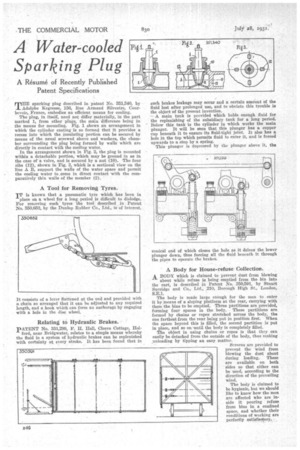A Water-cooled Sparking Plug
Page 64

If you've noticed an error in this article please click here to report it so we can fix it.
A Résumé of Recently Published Patent Specifications THE sparking plug described in patent No. 351,340, by Adolphe Kegresse, 156, Rue Armand Silvestre, Courbevoie, France, embodies an efficient means for cooling.
The plug, in itself, need not differ materially, in the part marked 1, from other plugs, the main difference being in the means for mounting. Fig. 1 shows an arrangement in which the cylinder casting is so formed that it provides a recess into which the insulating portion can be secured by means of the usual screwed sleeve and washers, the chamber surrounding the plug being formed by walls which are directly in contact with the cooling water.
In the arrangement shown in Pig. 2, the plug is mounted within a detachable portion, which may be ground in as in the case of a valve, and is secured by a nut (10). The four ribs (12), shown in Fig. 3, which is a sectional view on the line A B, support the walls of the water space and permit the cooling water to come in direct contact -with the comparatively thin walls of the member (2).
A Tool for Removing Tyres.
IT is known that a pneumatic tyre which has been in place on a wheel for a long period is difficult to dislodge. For removing such tyres the tool described in Patent• No. 350,652, by the Dunlop Rubber Co., Ltd., is of interest.
It consists of a lever flattened at the end and provided with a chain so arranged that it can be adjusted to any required length, and a hook which can form an anchorage by engaging with a hole in the disc wheel.
Relating to Hydraulic Brakes.
PATENT No. 351,299, P. H. Hall, Cleeve Cottage, Eelford, near Bridgwater, relates to a simple means whereby the fluid in a system of hydraulic brakes can be replenished with certainty at every stroke. It has been found that in such brakes leakage may occur and a certain amonnt of the fluid lost after prolonged use, and to obviate this trouble is the object of the present invention. A main tank is provided which holds enough fluid for the replenishing of the subsidiary tank for a long period. Below this tank is the cylinder in which works the main plunger. It will be seen that this plunger has a copper cup beneath it to ensure its fluid-tight joint. It also has a hole in the top which permits fluid to enter it, and is forced upwards to a stop by a spring. This plunger is depressed by the plunger above it, the conical end of which closes the hole as it drives the lower plunger down, thus forcing all the fluid beneath it through the pipes to operate the brakes.
• A Body for House-refuse Collection. A BODY which is claimed to prevent dust from blowing
about while refuse is being emptied from the bin into the cart, is described in Patent No. 350,591, by Stuart Surridge and Co., Ltd., 210, Borough High St., London, S.E.1.
The body is made large enough for the men to enter it by means of a sloping platform at the rear, carrying with them the bins to be emptied. Three partitions are provided, forming four spaces in the body. These partitions are formed by chains or ropes stretched across the body, the one farthest from the rear being put in position first. When the space beyond this is filled, the second partition is put in place, and so on until the body is completely filled.
The object in using chains or ropes is that they can easily be detached from the outside of the body, thus making unloading by tipping an easy matter.
Screens are provided to prevent the wind from blowing the dust about during loading. These are available on both sides so that either can be used, according to the direction of the prevailing wind.
The body is claimed to be hygienic, but we should like to know how the men are affected who are inside it pouring refuse from bins in a confined space, and whether their conditions of working are perfectly satisfactory.




































































































